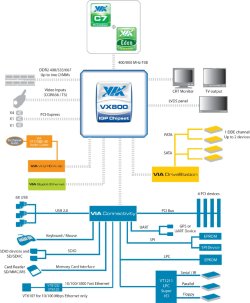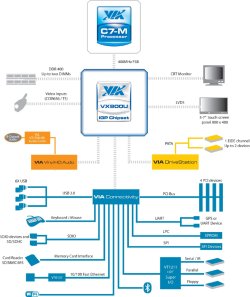Via chipset supports 64-bit mobile devices
Apr 7, 2008 — by Eric Brown — from the LinuxDevices Archive — 6 views Via Technology has released two core-logic chips targeting embedded devices, mini-PCs, mini-laptops, and UMPCs (ultra-mobie PCs). The VX800 and VX800U integrate northbridge and southbridge functionality plus other mobile-oriented functions, and pair up with Via's Eden, C7, C7-M, and upcoming Isaiah processors, according to the… company.
Via Technology has released two core-logic chips targeting embedded devices, mini-PCs, mini-laptops, and UMPCs (ultra-mobie PCs). The VX800 and VX800U integrate northbridge and southbridge functionality plus other mobile-oriented functions, and pair up with Via's Eden, C7, C7-M, and upcoming Isaiah processors, according to the… company.
(Click here for a larger view of Via's VX800)
The VX800 is a 33 x 33mm package rated for a maximum power consumption of five Watts, and said to be suitable for mini PCs, ultra-thin notebooks, and embedded devices. The VX800U is a 31 x 31mm ULV version rated for a TDP max of just 3.5 Watts, and said to be suitable for mini-notebooks and UMPCs.
The products compare with Via's prior VX700, which had a TDP max of 3.5 watts but came in a 35 x 35mm package. The VX700 has made it into a variety of devices, ranging from the OQO UMPC to Via's little PX10000G Pico-ITX motherboard.
The VX800 series chips will cover the same gamut of devices, while saving precious space. Crucially, they also support the company's 64-bit “Isaiah” architecture, due to ship this spring. Isaiah-based processors will outperform the company's current C7/Eden chips by 200 to 300 percent, within the same power envelope, Via claims.


Block diagrams of Via's VX800 and VX800u
(Click either to enlarge)
As the larger and thirstier chip, the VX800 includes a few features the VX800U does not. For example, the VX800 supports gigabit Ethernet, while the VX800U only supports 10/100. Other differences are noted in the list that follows.
Features of the VX800 and VX800U, according to Via, include:
- Processor support:
- C7, Eden, and Isaiah (VX800)
- C7-M and Isaiah (VX800U)
- C7, Eden, and Isaiah (VX800)
- Frontside bus speeds:
- 400/800MHz (VX800)
- 400MHz (VX800U)
- 400/800MHz (VX800)
- Memory controller — supports up to two 64-bit DDR2 667MHz DIMMs (4GB max)
- Audio interface:
- Up to 32-bit sample depth at 192kHz sampling rate
- Supports three codecs and eight channels
- Up to 32-bit sample depth at 192kHz sampling rate
- Integrated 2D/ 3D/Video processor:
- 250MHz clock speed (VX800)
- 166MHz clock speed (VX800U)
- Via Chrome9 2D/3D engine with DirectX 9 compatibility and hardware rotation capability
- High Definition video processor with VMR capability
- Up to 256MB frame buffer
- MPEG-2, MPEG-4, VC1 and DiVX video acceleration
- 250MHz clock speed (VX800)
- Display interface:
- Three 10-bit 350MHz RAMDACs
- Single- or dual-channel LVDS
- 18-bit TTL LCD interface
- Supports dual displays
- Multiplexed with UART and IR ports
- Three 10-bit 350MHz RAMDACs
- Video capture port
- Storage interface:
- SATA 2.0 (VX800 only)
- UDMA IDE
- SD/MMC/MS memory cards
- SATA 2.0 (VX800 only)
- Peripheral interfaces:
- 1 x 4-lane and 2 x 1-lane PCI Express ports (VX800 only)
- 6 x USB 2.0
- 2 x serial
- PCI and LPC bus support
- SDIO and SPI
- FIR
- 1 x 4-lane and 2 x 1-lane PCI Express ports (VX800 only)
- Power management:
- ACPI 3.0 and PCI Bus Power Management 1.1 compliant
- Extensive system power management
- ACPI 3.0 and PCI Bus Power Management 1.1 compliant
According to Via, the VX800 and VX800U will begin shipping this month. Earlier this week, Everex said it would use the chipset in its forthcoming Cloudbook Max mini-laptop.
This article was originally published on LinuxDevices.com and has been donated to the open source community by QuinStreet Inc. Please visit LinuxToday.com for up-to-date news and articles about Linux and open source.